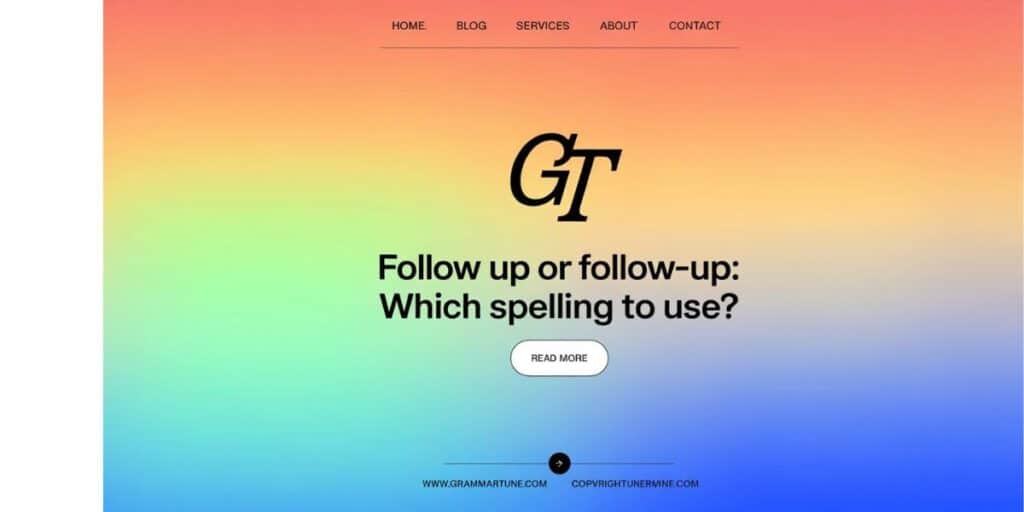Follow Up or Follow-Up: Which Spelling to Use? This common question trips up even seasoned writers. Understanding when to use follow up versus follow-up can sharpen your communication and prevent embarrassing grammar slip-ups.
The difference hinges on function—verb or noun/adjective. In this guide, you’ll learn the correct usage, see real-world examples, and discover tips to remember the rule. Mastering this small detail can elevate your professional writing.
Whether you’re sending a follow-up email, planning a follow-up call, or deciding to follow up on a task, clarity matters. Let’s break it down.
📖 Grammar & Usage Guide
- ✍️ What is the Difference Between Follow Up and Follow-Up?
- 📅 When to Use Follow Up
- 📎 When to Use Follow-Up
- 🧠 Trick to Remember the Difference
- 🔠 Grammatical Clues
- ❓ Why is There Confusion?
🛠️ Examples, Synonyms & More
- 📬 Follow-up and Follow up Examples
- 💼 Examples of Follow Up
- 📧 Examples of Follow-Up
- 🔄 Synonyms for Follow Up
- 📄 Synonyms for Follow-Up
- 📚 Etymology of Follow Up
- 🧾 Etymology of Follow-Up
- 💬 “Follow Up or Follow-Up”: Which One Should You Use?
- 📌 FAQs
- ✅ Conclusion
📌 When to Use Follow Up
Use follow up as a verb when you’re talking about taking action.
For example, you might follow up on a job interview or email.
It shows you’re continuing something already started. ✅
Keep in mind: if you can add “to” in front of it, it’s likely a verb.
You’ll often use it after meetings, calls, or emails.
Always follow up when something important needs attention. 🔁
Must read: Appendices or Appendixes? Clarifying Usage
✨ Follow-up vs. Followup
The hyphen matters here—follow-up is correct, not followup.
Followup without the hyphen is a common error in informal writing. ❌
Use the hyphenated version when you need a noun or adjective.
So, say “follow-up appointment,” not “followup appointment.”
In formal writing, that dash changes everything.
It’s a small mark with a big impact. 💥
📚 Follow-up and Follow up Examples
Follow up: “I’ll follow up with the client tomorrow.”
Follow-up: “She scheduled a follow-up visit next week.”
The difference is all about how you’re using the words. 🧠
Seeing both in action clears up confusion.
Try to write your own examples to lock in the rule.
Practice really does make perfect. ✍️
💬 Write with Confidence
Knowing when to use follow up vs. follow-up boosts your clarity.
It makes your writing sound polished and professional. 🖋️
No second-guessing yourself anymore.
With these grammar tips in your toolkit, you’ll sound sharp.
Don’t let small errors hold you back.
Write like you mean it—with confidence. 💪
🔍 What is the Difference Between Follow Up and Follow-Up?
Follow up is a verb. You do it.
Follow-up is a noun or adjective. It describes something.
Same words, different grammar rules. 🎯
This is a common source of confusion.
Think: action = follow up, thing = follow-up.
That rule works every time. ✅
📅 When to Use Follow Up
Use it when you need to talk about an action.
Like: “I’ll follow up on that email later today.”
It’s something you’re actively doing. 🏃♂️
This form usually comes after verbs like “need to” or “want to.”
“Don’t forget to follow up on the report.”
Super handy in business writing. 💼
📎 When to Use Follow-up
Use follow-up when it’s a thing, like an email or call.
Example: “Let’s schedule a follow-up discussion.”
You’re naming a type of event or item. 📄
If you can put “the” in front, use the hyphen.
Like “the follow-up” or “a follow-up plan.”
Easy trick to remember. 🧠
🧠 Trick to Remember the Difference
Here’s the golden rule: Follow up = action. Follow-up = thing.
No hyphen? It’s a verb. Hyphen? It’s a noun/adjective. ✔️
Test it by inserting “to” or “a.” It helps!
Say: “I need to follow up.” ✅
Say: “I received a follow-up.” ✅
Your sentence will tell you what’s right. 🗣️
❓ Why is There Confusion?
They look almost identical, and spell-check often misses it.
Plus, both are common in emails and business chats.
That’s why so many people get tripped up. 🤯
Knowing grammar helps—but so does practice.
Once you see the difference, it sticks.
Start noticing how it’s used in real life. 🔍
You will like: What’s the Plural of Basis? Is it Baseis or Bases?
⚡ Quick Summary
Confused about Follow Up or Follow-Up: Which Spelling to Use? 🤔 You’re not alone. Here’s the fast breakdown:
- ✅ Use follow up (no hyphen) as a verb – “I’ll follow up tomorrow.”
- 📌 Use follow-up (with a hyphen) as a noun or adjective – “Let’s schedule a follow-up call.”
- ❌ Avoid “followup” – it’s incorrect in formal writing.
- 🧠 Tip: If you can add “to,” it’s a verb. If you can add “a” or “the,” it’s a noun.
🔄 What Does “Follow Up” Mean?
It means to continue or act again after something.
Like contacting someone or checking progress.
“I’ll follow up with the vendor tomorrow.” 📞
It’s all about taking action.
Think progress, not paperwork.
Very common in customer service and jobs. 🧑💻
📎 What Does “Follow-Up” Mean?
This refers to something that happens after an action.
Like a follow-up message, visit, or plan.
It’s the result or next step. 📬
You’ll use this form to name or describe that step.
Example: “We had a follow-up appointment last week.”
One little hyphen makes all the difference. 🔠
🤔 “Follow Up or Follow-Up”: Which One Should You Use?
Ask yourself—is this an action or a thing?
That’s your answer right there. 🎯
Action? Use follow up. Things? Use follow-up.
Let your sentence guide the way.
Swap in “to” or “the” and test it.
Grammar doesn’t have to be a guessing game. ✅
📞 When to Use “Follow Up”
Use it for verbs like “need to,” “should,” or “will.”
“I will follow up after our meeting.”
It’s something you do, not something you hold. 🔧
Try speaking the sentence out loud.
It should sound like you’re taking action.
Simple, right? 😄
🗂️ When to Use “Follow-Up”
Use this when describing a noun or using it as one.
“We had a follow-up meeting on Tuesday.”
Here, follow-up tells what kind of meeting. 🗓️
It’s often paired with nouns like email, plan, or call.
Don’t forget that dash—it’s important!
Always check the grammar function. ✅
🧩 Grammatical Clues
Look at where it falls in the sentence.
After a verb? Probably follow up.
Before a noun? It’s likely a follow-up. 🧠
Example: “I’ll follow up soon.”
Example: “Let’s review the follow-up plan.”
Pay attention to what comes before or after. 🕵️
🧵 Synonyms for “Follow Up” and “Follow-Up”
Sometimes, switching the words can help.
You don’t always have to repeat follow up or follow-up.
Mix it up with these alternatives. 🔄
They keep your writing fresh and clear.
Here’s a quick list to help. 👇
✅ Synonyms for “Follow Up” (verb)
- Check in
- Reach out
- Get back to
- Reconnect
- Revisit
- Circle back 🔄
📄 Synonyms for “Follow-Up” (noun/adjective)
- Next step
- Return visit
- Review
- Post-meeting action
- Reminder
- Continuation 📌
🧾 Examples in Context
Seeing follow up and follow-up in full sentences helps.
Here are real-life examples to make it stick.
Use them as a reference when you write. ✍️
It’s much easier to learn by doing.
Try swapping out the examples with your own words.
Make it personal and practical. 💬
💼 Examples of Follow up
- I need to follow up with the client.
- Don’t forget to follow up on that task.
- Will you follow up with her this week?
📧 Examples of Follow-Up
- We scheduled a follow-up meeting.
- I sent a follow-up email yesterday.
- The follow-up report was helpful.
📚 Etymology of “Follow Up” and “Follow-Up”
These terms trace back to the idea of “pursuing something.”
They entered business language in the early 1900s.
Now they’re part of everyday communication.
📜 Etymology of “Follow Up”
Derived from the verb “follow,” meaning to come after.
“Up” adds a sense of continuation or pursuit.
Together, they imply action with intent. 🎯
🧾 Etymology of “Follow-Up”
This came later, as a noun form of the verb phrase.
Used to describe the outcome or product of following up.
It’s common in medical, sales, and project contexts. 💼
You will like: Traveler or Traveller: Which Spelling is Right?
FAQ’S
Is it “followup” or “follow-up”?
It depends on how you’re using it! Use follow up as a verb (e.g., “I’ll follow up tomorrow”) and follow-up as a noun or adjective (e.g., “She sent a follow-up email”). 🔍
Can I write “followup” without the hyphen?
Technically, no. ❌ Followup is incorrect in formal writing. The correct noun or adjective form is follow-up with a hyphen. Always double-check your spelling. ✅
What are some examples of “follow-up”?
Sure! Try:
- “We had a follow-up meeting.”
- “She scheduled a follow-up appointment.”
These describe events or actions that come after something else. 🗓️
How do I know when to use “follow up” as a verb?
Ask yourself: Is someone doing something? If yes, it’s a verb.
Example: “He will follow up with the team.”
If it’s an action, use the two-word version. 🔧
What’s a quick trick to remember the difference?
Easy! 💡 If you can put “to” in front, use follow up (verb).
If you can put “a” or “the” in front, use follow-up (noun).
Your sentence will tell you what sounds right. 👂
Conclusion
Follow Up or Follow-Up: Which Spelling to Use? It all comes down to grammar. Use follow up as a verb when describing an action you take, like calling or emailing someone.
Use follow-up as a noun or adjective when referring to a thing—like a follow-up appointment or message. Getting it right makes your writing clearer and more professional.
Now that you know the difference, you can write with confidence and avoid common mistakes. Master this small detail, and your communication will stand out for all the right reasons. 📝✨

Joulia, a seasoned wordsmith and grammar enthusiast, brings over a decade of blogging expertise to Grammar Tune. With a keen eye for linguistic precision and a passion for making complex grammar concepts accessible, he has helped thousands of readers enhance their writing skills. His engaging teaching style and practical approach to language learning have made him a trusted voice in the online grammar community.







